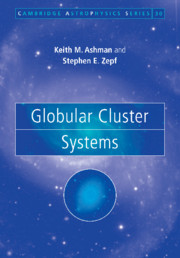Book contents
- Frontmatter
- Contents
- Preface
- 1 Introduction
- 2 Properties of globular clusters
- 3 The Galactic globular cluster system
- 4 Globular cluster systems in nearby galaxies
- 5 Properties of extragalactic globular cluster systems
- 6 Globular clusters and galaxy formation
- 7 The formation of globular clusters
- 8 Future prospects
- Appendix
- References
- Subject index
- Object index
7 - The formation of globular clusters
Published online by Cambridge University Press: 21 September 2009
- Frontmatter
- Contents
- Preface
- 1 Introduction
- 2 Properties of globular clusters
- 3 The Galactic globular cluster system
- 4 Globular cluster systems in nearby galaxies
- 5 Properties of extragalactic globular cluster systems
- 6 Globular clusters and galaxy formation
- 7 The formation of globular clusters
- 8 Future prospects
- Appendix
- References
- Subject index
- Object index
Summary
At present, there is no widely accepted theory of globular cluster formation. In this chapter, we describe some of the general ideas that have been proposed in this area, and compare these ideas with the constraints placed on globular cluster formation models by the observations described in earlier chapters.
One piece of evidence that has played an important role in the development of this field is the lack of current globular cluster formation in the Milky Way today. Open clusters and stellar associations form quite happily at the present epoch in the Galactic disk, but globular clusters do not. Until relatively recently, a significant fraction of astronomers would have probably argued that globular cluster formation was something that only occurred in the early universe. Others have claimed for some time that the most massive young star clusters found in the Large Magellanic Cloud and other similar environments are genuine analogs of the old globular clusters of the Milky Way and other galaxies. As discussed in Chapter 5, there is now evidence that globular clusters are currently forming in merging and interacting galaxies. While it is premature to regard this evidence as conclusive, there seems to be a growing acceptance of the idea that globular clusters can, under certain circumstances, form at the present epoch. As we show below, this possibility has significant consequences for models of globular cluster formation.
- Type
- Chapter
- Information
- Globular Cluster Systems , pp. 124 - 143Publisher: Cambridge University PressPrint publication year: 1998
- 1
- Cited by

